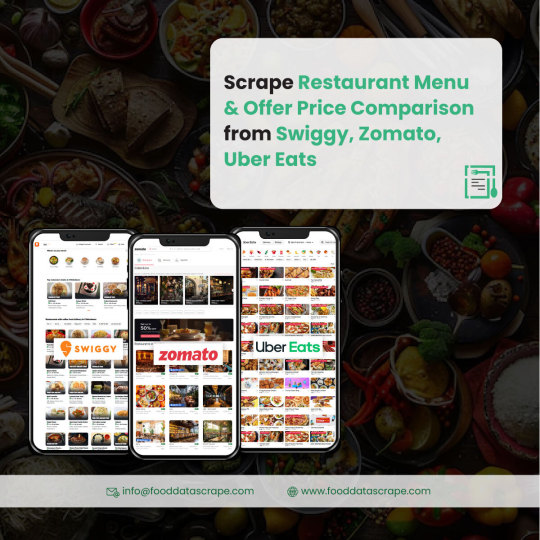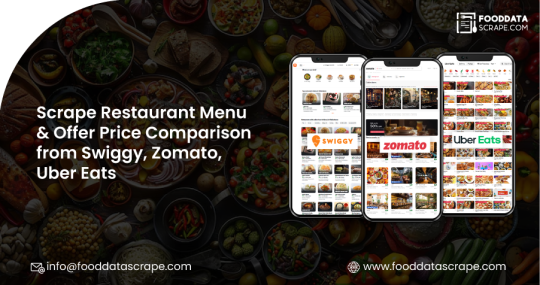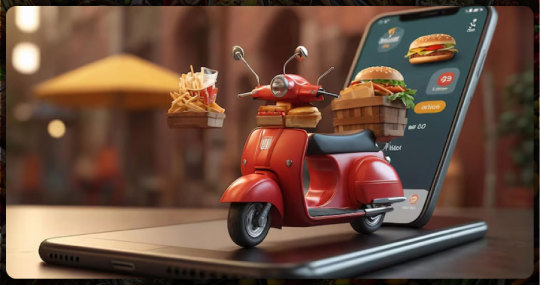#UberEatsRestaurantMenuDataScraping
Explore tagged Tumblr posts
Text
Scrape Menu & Offer Prices from Swiggy, Zomato, Uber Eats

Discover how scraping restaurant and menu data from Swiggy, Zomato & Uber Eats helps food startups optimize pricing, track trends & build smart strategies.
Read More>> https://www.fooddatascrape.com/scrape-restaurant-menu-price-swiggy-zomato-ubereats.php
#ScrapeRestaurantMenuOfferPrice#SwiggyRestaurantMenuDataScraping#ZomatoRestaurantMenuDataScraping#UberEatsRestaurantMenuDataScraping#RestaurantandMenuDataScraping
0 notes
Text

Extract menu data from Uber Eats for McDonalds in New Zealand to analyze offerings and optimize local market strategies.
Source: https://www.iwebdatascraping.com/extract-menu-data-from-uber-eats-for-mcdonalds-in-new-zealand.php
#WebScrapingUberEatsFoodDeliveryData#ExtractMenuDataFromUberEatsForMcDonaldsinNewZealand#ExtractMenuDataFromUberEatsForMcDonalds#FoodDeliveryDataExtraction#UberEatsRestaurantMenuDataScraper#RestaurantDataStoreLocationDataCollection
0 notes
Text
Scrape Menu & Offer Prices from Swiggy, Zomato, Uber Eats
Discover how scraping restaurant and menu data from Swiggy, Zomato & Uber Eats helps food startups optimize pricing, track trends & build smart strategies.
Read More>> https://www.fooddatascrape.com/scrape-restaurant-menu-price-swiggy-zomato-ubereats.php
#ScrapeRestaurantMenuOfferPrice#SwiggyRestaurantMenuDataScraping#ZomatoRestaurantMenuDataScraping#UberEatsRestaurantMenuDataScraping#RestaurantandMenuDataScraping
0 notes
Text
Scrape Menu & Offer Prices from Swiggy, Zomato, Uber Eats

Scrape Restaurant Menu & Offer Price Comparison from Swiggy, Zomato, Uber Eats
Introduction
In the fast-evolving world of food delivery, pricing has emerged as a powerful differentiator. From delivery charges to promotional offers and menu item pricing, every detail influences customer choice and restaurant profitability. For investors and food startups, accurate data on Restaurant Menu & Offer Price Comparison across Swiggy, Zomato, and Uber Eats provides the foundation for building competitive strategies, tracking performance, and fine-tuning Restaurant Menu Pricing Strategies in real time.
With the rise of app-based food ordering, traditional menu pricing has evolved into a dynamic science driven by data, location, competitor benchmarking, and AI-led personalization. Platforms like Swiggy, Zomato, and Uber Eats frequently experiment with pricing levers such as item-level discounts, combo offers, delivery fees, platform charges, and surge pricing.
To capture the full picture, Restaurant and Menu Data Scraping from Swiggy, Zomato, Uber Eats has become a game-changer. By programmatically extracting structured data from these apps and websites, businesses gain real-time insights into how competitors price menus, which offers drive the most traction, and how pricing fluctuates by city, category, or restaurant type.
Why Price Comparison Matters for Food Startups & Investors

In the crowded online food delivery market, pricing is not just about affordability—it's about positioning, psychology, and platform visibility. Consider the following use cases:
Performance Benchmarking: Measure how a restaurant’s pricing compares to nearby competitors in the same cuisine category.
Dynamic Pricing: Adjust pricing based on demand, competitor movement, or historical performance.
Promotion Optimization: Track which offers yield the best ROI and when to deploy them.
Investor Due Diligence: Validate growth potential and unit economics based on market-level menu pricing and promotional strategies.
Brand Consistency Audits: Ensure menu prices and descriptions are consistent across cities or platforms.
Key Data Points to Extract

A comprehensive Restaurant Menu & Offer Price Comparison relies on multiple granular data points, including:
Restaurant name and location
Cuisine type and category
Individual menu items and combos
Base price, taxes, and packaging charges
Platform-specific fees (e.g., delivery, convenience)
Current promotions (BOGO, % off, free delivery)
Historical pricing trends
Ratings and reviews
Estimated delivery time
These insights—when scraped regularly—can be converted into actionable dashboards and models for price optimization and performance tracking.
How Restaurant and Menu Data Scraping Works

To extract data from platforms like Swiggy, Zomato, and Uber Eats, businesses typically use web scraping tools, mobile app data capture, or Food delivery price comparison India APIs. The core process includes:/p>
1. Crawling: Navigating through restaurant listings and menus.
2. Parsing: Extracting relevant data fields using HTML selectors or JSON endpoints.
3. Cleaning: Removing duplicates, correcting formats, and ensuring consistency.
4. Storage: Loading data into databases or business intelligence tools.
5. Analysis: Comparing prices, visualizing trends, and generating alerts.
For example:
Swiggy Restaurant Menu data scraping involves extracting data from mobile APIs and app screens, where dynamic content is loaded via JSON.
Zomato Restaurant Menu data scraping focuses on their web and app menus, where offers and prices are often customized by user location.
Uber Eats Restaurant Menu data scraping combines browser automation and API interaction due to their modern tech stack and heavy JavaScript use.
Platform-Specific Strategies

Swiggy Restaurant Menu Data Scraping
API calls are often tied to geo-coordinates and user IDs.
Restaurants and item prices change dynamically based on time of day.
Offers like “50% off up to ₹100” or “Free delivery above ₹149” are embedded in metadata.
Data must be refreshed every few hours for real-time relevance.
Zomato Restaurant Menu Data Scraping
Menu data is available on both web and app; app versions tend to be more updated.
Offers vary by location, user history, and time.
Zomato’s structured web layout allows clean parsing of item details, nutrition info, and trending dishes.
Scraping must respect rate limits and mimic natural browsing patterns.
Uber Eats Restaurant Menu Data Scraping
Content is delivered via client-side JavaScript, so scraping requires headless browsers or Puppeteer/Selenium.
Menu prices may include service fees by default.
Uber Eats frequently runs personalized promotions—tracking multiple user profiles offers deeper insights.
Applications for Dynamic Pricing & Business Intelligence

Real-time Restaurant Menu & Offer Price Comparison enables the following:
Dynamic Pricing Engines : AI-driven pricing models adjust based on competitor data and demand signals.
Revenue Management : Restaurants optimize their pricing sweet spot to balance margin and conversion.
Investor Analytics Dashboards : Monitor top restaurant performance, pricing movements, and market saturation.
Offer Performance Reports : Identify which discounts drive the highest basket size and repeat orders.
Geo-Intelligence Mapping : Visualize pricing patterns across cities, neighborhoods, or store clusters.
Challenges in Restaurant Menu Scraping

While powerful, Restaurant and Menu Data Scraping from Swiggy, Zomato, Uber Eats does face technical and ethical hurdles:
Frequent UI/API changes: These platforms update layouts and endpoints often to block scraping.
Bot Detection: CAPTCHA, rate limiting, and device fingerprinting block non-human behavior.
Dynamic Content: Many menus load via JavaScript, requiring headless browser automation.
Data Volume: With millions of SKUs and daily changes, managing scale is critical.
Legal Compliance: Ensure scraping practices are compliant with local data and privacy regulations.
Working with experienced data partners ensures these challenges are addressed securely and effectively.
Future of Real-Time Menu Price Tracking

The demand for Real-time menu price tracking tools will grow as food delivery becomes more competitive and data-driven. Here's what the future holds:
Predictive Pricing: Use AI to forecast optimal pricing per time slot or day.
Sentiment Analysis: Combine pricing data with reviews to assess value perception.
Multi-platform Integration: Unified view across Swiggy, Zomato, Uber Eats, and emerging players.
Voice/AI Interfaces: Automate price alerts and competitive insights via dashboards or chatbots.
Custom Alerts: Get notified when competitors change pricing or launch new offers.
Use Cases by Stakeholder Type
Startups & Cloud Kitchens
Optimize pricing before a new location launch.
Run A/B tests for promotions based on competitor strategies.
Identify cuisine-specific price trends.
Investors & Analysts
Validate portfolio company pricing efficiency.
Track regional growth and saturation via pricing heatmaps.
Compare multi-brand strategies in aggregator ecosystems.
FMCG and Delivery Brands
Benchmark product placement across restaurant menus.
Assess how brands are bundled or priced on food delivery platforms.
Track promotions involving their SKUs in real-time.
Conclusion
The food delivery ecosystem thrives on data, and Restaurant Menu & Offer Price Comparison is at the core of strategic pricing decisions. Whether you're a fast-growing startup, an established cloud kitchen, or an investor seeking clarity on food tech economics—scraping restaurant and menu data across Swiggy, Zomato, and Uber Eats offers a competitive edge.
As platforms become more personalized and AI-led, static pricing won’t be enough. You need Real-time menu price tracking tools powered by intelligent Restaurant and Menu Data Scraping from Swiggy, Zomato, Uber Eats. Automate, analyze, and act faster than your competitors.
Are you in need of high-class scraping services? Food Data Scrape should be your first point of call. We are undoubtedly the best in Food Data Aggregator and Mobile Grocery App Scraping service and we render impeccable data insights and analytics for strategic decision-making. With a legacy of excellence as our backbone, we help companies become data-driven, fueling their development. Please take advantage of our tailored solutions that will add value to your business. Contact us today to unlock the value of your data.
Read More>> https://www.fooddatascrape.com/scrape-restaurant-menu-price-swiggy-zomato-ubereats.php
#ScrapeRestaurantMenuOfferPrice#SwiggyRestaurantMenuDataScraping#ZomatoRestaurantMenuDataScraping#UberEatsRestaurantMenuDataScraping#RestaurantandMenuDataScraping
0 notes
Text
Extract Menu Data from Uber Eats for McDonalds in New Zealand

Why Should Business Extract Menu Data from Uber Eats for McDonald's in New Zealand?
In the ever-evolving food delivery sector, obtaining accurate and current menu data is vital for businesses, analysts, and researchers. For global giants like McDonald's, which operates in various countries, including New Zealand, the ability to extract menu data from Uber Eats for McDonald's in New Zealand offers crucial insights into consumer preferences, market trends, and competitive strategies. By leveraging services that scrape McDonald's menu data from Uber Eats in New Zealand, businesses can gain valuable information that enhances decision-making and strategy formulation. This article explores the nuances of restaurant data scraping services, detailing how they can effectively support restaurants and similar brands in optimizing their market approach and understanding customer behavior.
The Importance of Menu Data Extraction
McDonald's menu data scraping from Uber Eats in New Zealand involves collecting comprehensive information about food items, including descriptions, prices, ingredients, and nutritional details. This data extraction is instrumental for businesses in several key areas:
1. Market Analysis: Businesses can gain valuable insights into local customer preferences and purchasing behaviors by leveraging food delivery data extraction. This analysis helps the brand tailor its offerings to align with regional tastes and preferences, boosting customer satisfaction and driving sales. Understanding these preferences allows it to adapt its menu to meet the specific demands of the New Zealand market.
2. Competitive Benchmarking: By web scraping Uber Eats food delivery data, businesses can keep track of competitors' menu items, pricing strategies, and promotional activities. This competitive intelligence is crucial for refining marketing strategies and maintaining a competitive edge. By comparing their offerings with those of competitors, businesses can make informed decisions to enhance their market position.
3. Menu Optimization: Detailed data from Uber Eats restaurant menu data scraping services enables restaurants to optimize their menus. By analyzing factors such as item popularity, profitability, and seasonal trends, restaurants can ensure that their menu remains relevant and appealing. This optimization process involves updating or removing underperforming items and introducing new ones based on current trends and customer preferences.
4. Price Adjustments: Real-time data extraction through Uber Eats restaurant scraping API services allows monitoring pricing trends and making necessary adjustments. Tracking competitor pricing and market changes ensures that the pricing strategy remains competitive and aligns with market expectations. This flexibility in pricing helps businesses maintain their market position and respond effectively to changes in consumer demand.
5. Customer Insights: By analyzing the data obtained from an Uber Eats restaurant menu data scraper, businesses can better understand customer preferences and trends. This insight enables the creation of targeted marketing campaigns and promotions that resonate with their audience. Tailoring marketing efforts based on detailed menu data helps them engage more effectively with their customers and enhance their overall marketing strategy.
Overview of Uber Eats in New Zealand
Uber Eats, a leading player in the food delivery sector, operates extensively in New Zealand, connecting consumers with various restaurants, including global brands like McDonald's. The platform allows customers to explore detailed menus, place orders, and enjoy swift delivery services. For businesses, Uber Eats is a valuable resource for gathering data on consumer behavior and market trends. Businesses can gain insights into customer preferences and competitive dynamics by using tools to extract McDonald's food delivery data. Employing strategies to scrape McDonald's restaurant menu data offers a comprehensive view of menu items and pricing. This information is critical for optimizing menu offerings and pricing strategies. An efficient McDonald's food delivery data scraper ensures accurate and timely data collection, supporting better decision-making and strategic planning for similar brands.
Critical Aspects of Menu Data on Uber Eats
When extracting menu data from Uber Eats for McDonald's in New Zealand, several key aspects are considered:
1. Item Descriptions: Each Uber Eats menu item has a description highlighting its ingredients, preparation style, and unique features. For McDonald's, this includes detailed descriptions of their burgers, fries, drinks, and other offerings.
2. Pricing Information: Prices for each menu item are prominently displayed, allowing for an accurate assessment of the cost structure. This information is crucial for pricing strategy and comparative analysis.
3. Nutritional Information: Many menu items on Uber Eats include nutritional information such as calorie count, fat content, and other dietary details. This data helps consumers make informed choices and enables to provide transparency.
4. Images: High-quality images of menu items are often included, giving customers a visual representation of what to expect. These images help maintain consistent brand image and appealing presentation.
5. Availability: The availability of menu items can vary based on location, time, and stock. Extracting this data helps in understanding which items are popular and frequently available.
6. Promotions and Discounts: Uber Eats often features promotional offers and discounts. Extracting information about these promotions helps businesses plan and execute marketing strategies.
Applications of Extracted Menu Data
Once the menu data is extracted, it can be leveraged in numerous ways to drive business growth and strategic decision-making:
1. Data-Driven Decision Making: Analyzing McDonald's restaurant menu datasets helps McDonald's make informed decisions regarding menu modifications, new product launches, and marketing strategies. By leveraging these insights, brands can enhance operational efficiency and ensure their offerings align with consumer preferences. Web scraping restaurant menu data provides detailed and actionable information, facilitating more precise decision-making.
2. Personalization: Understanding local preferences and trends through Uber Eats restaurant menu datasets enables companies to create personalized offers and recommendations tailored to customers in New Zealand. This targeted approach increases customer engagement and loyalty by addressing specific regional tastes and preferences.
3. Inventory Management: Detailed menu data aids in forecasting demand and managing inventory more effectively. By analyzing restaurant data store location data collection, businesses can maintain optimal stock levels, reduce waste, and ensure that popular items are always available. This efficient inventory management is crucial for minimizing operational costs and maximizing profitability.
4. Regional Strategies: Insights from restaurant menu data scraper allow McDonald's to develop strategies specific to different regions. For instance, restaurant businesses can introduce local flavors or special limited-time offers based on the popularity of certain items in New Zealand. This regional customization helps appeal more directly to local markets and boost sales.
5. Enhanced Customer Experience: Accurate and comprehensive menu information enhances customer experience. Customers are better equipped to make informed choices, which leads to higher satisfaction and a more positive perception of the brand. By utilizing McDonald's restaurant menu datasets, restaurant owners can ensure that their menu details are accurate and appealing to their customer base.
Future Trends and Considerations
As the food delivery industry continues to evolve, several trends and considerations are likely to influence menu data extraction:
1. Integration with AI and Machine Learning: Advanced technologies such as AI and machine learning will play a crucial role in analyzing and interpreting menu data. These technologies can provide deeper insights and predictive analytics, enhancing decision-making processes.
2. Increased Focus on Health and Nutrition: Consumers are becoming more health- conscious, and there is a growing demand for detailed nutritional information. Businesses may need to provide more comprehensive data to meet these expectations.
3. Expansion of Delivery Platforms: With new food delivery platforms emerging, several restaurant businesses will need to adapt data extraction strategies to include a broader range of sources.
4. Real-Time Data Access: sources. 4. Real-Time Data Access: The ability to access real-time data will become increasingly important for staying competitive and responding swiftly to market changes.
Conclusion
Extract menu data from Uber Eats for McDonald's in New Zealand to gain valuable insights into market trends, customer preferences, and competitive dynamics. By leveraging this data, owners can make informed decisions, optimize their menu, and enhance the overall customer experience. As the industry continues to evolve, the importance of accurate and timely menu data will only grow, making it a critical component of strategic planning and business success.
Experience top-notch web scraping service and mobile app scraping solutions with iWeb Data Scraping. Our skilled team excels in extracting various data sets, including retail store locations and beyond. Connect with us today to learn how our customized services can address your unique project needs, delivering the highest efficiency and dependability for all your data requirements.
Source: https://www.iwebdatascraping.com/extract-menu-data-from-uber-eats-for-mcdonalds-in-new-zealand.php
#WebScrapingUberEatsFoodDeliveryData#ExtractMenuDataFromUberEatsForMcDonaldsinNewZealand#ExtractMenuDataFromUberEatsForMcDonalds#FoodDeliveryDataExtraction#UberEatsRestaurantMenuDataScraper#RestaurantDataStoreLocationDataCollection
0 notes